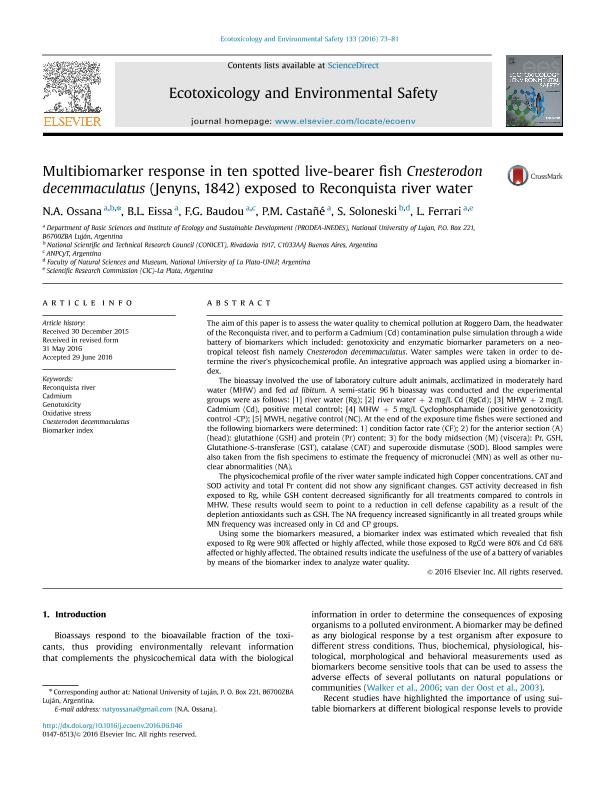Artículo
Multibiomarker response in ten spotted live-bearer fish Cnesterodon decemmaculatus (Jenyns, 1842) exposed to Reconquista river water
Ossana, Natalia Alejandra ; Eissa, Bettina Lorena
; Eissa, Bettina Lorena ; Baudou, Federico Gastón
; Baudou, Federico Gastón ; Castañé, Patricia Mónica; Soloneski, Sonia Maria Elsa
; Castañé, Patricia Mónica; Soloneski, Sonia Maria Elsa ; Ferrari, Lucrecia
; Ferrari, Lucrecia
 ; Eissa, Bettina Lorena
; Eissa, Bettina Lorena ; Baudou, Federico Gastón
; Baudou, Federico Gastón ; Castañé, Patricia Mónica; Soloneski, Sonia Maria Elsa
; Castañé, Patricia Mónica; Soloneski, Sonia Maria Elsa ; Ferrari, Lucrecia
; Ferrari, Lucrecia
Fecha de publicación:
11/2016
Editorial:
Academic Press Inc Elsevier Science
Revista:
Ecotoxicology and Environmental Safety
ISSN:
0147-6513
Idioma:
Inglés
Tipo de recurso:
Artículo publicado
Clasificación temática:
Resumen
The aim of this paper is to assess the water quality to chemical pollution at Roggero Dam, the headwater of the Reconquista river, and to perform a Cadmium (Cd) contamination pulse simulation through a wide battery of biomarkers which included: genotoxicity and enzymatic biomarker parameters on a neotropical teleost fish namely Cnesterodon decemmaculatus. Water samples were taken in order to determine the river's physicochemical profile. An integrative approach was applied using a biomarker index. The bioassay involved the use of laboratory culture adult animals, acclimatized in moderately hard water (MHW) and fed ad libitum. A semi-static 96 h bioassay was conducted and the experimental groups were as follows: [1] river water (Rg); [2] river water + 2 mg/L Cd (RgCd); [3] MHW + 2 mg/L Cadmium (Cd), positive metal control; [4] MHW + 5 mg/L Cyclophosphamide (positive genotoxicity control -CP); [5] MWH, negative control (NC). At the end of the exposure time fishes were sectioned and the following biomarkers were determined: 1) condition factor rate (CF); 2) for the anterior section (A) (head): glutathione (GSH) and protein (Pr) content; 3) for the body midsection (M) (viscera): Pr, GSH, Glutathione-S-transferase (GST), catalase (CAT) and superoxide dismutase (SOD). Blood samples were also taken from the fish specimens to estimate the frequency of micronuclei (MN) as well as other nuclear abnormalities (NA). The physicochemical profile of the river water sample indicated high Copper concentrations. CAT and SOD activity and total Pr content did not show any significant changes. GST activity decreased in fish exposed to Rg, while GSH content decreased significantly for all treatments compared to controls in MHW. These results would seem to point to a reduction in cell defense capability as a result of the depletion antioxidants such as GSH. The NA frequency increased significantly in all treated groups while MN frequency was increased only in Cd and CP groups. Using some the biomarkers measured, a biomarker index was estimated which revealed that fish exposed to Rg were 90% affected or highly affected, while those exposed to RgCd were 80% and Cd 68% affected or highly affected. The obtained results indicate the usefulness of the use of a battery of variables by means of the biomarker index to analyze water quality.
Archivos asociados
Licencia
Identificadores
Colecciones
Articulos(CCT - LA PLATA)
Articulos de CTRO.CIENTIFICO TECNOL.CONICET - LA PLATA
Articulos de CTRO.CIENTIFICO TECNOL.CONICET - LA PLATA
Articulos(INEDES)
Articulos de INSTITUTO DE ECOLOGIA Y DESARROLLO SUSTENTABLE
Articulos de INSTITUTO DE ECOLOGIA Y DESARROLLO SUSTENTABLE
Citación
Ossana, Natalia Alejandra; Eissa, Bettina Lorena; Baudou, Federico Gastón; Castañé, Patricia Mónica; Soloneski, Sonia Maria Elsa; et al.; Multibiomarker response in ten spotted live-bearer fish Cnesterodon decemmaculatus (Jenyns, 1842) exposed to Reconquista river water; Academic Press Inc Elsevier Science; Ecotoxicology and Environmental Safety; 133; 11-2016; 73-81
Compartir
Altmétricas



